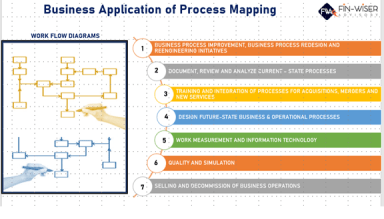
Originally published: 08/09/2020 06:46
Publication number: ELQ-34002-1
View all versions & Certificate
Publication number: ELQ-34002-1
View all versions & Certificate

Business Application of Process Mapping
Powerful technique to give clear understanding of Business Application of Process Mapping.
process mappingbusiness applicationprocess improvementprocess reengineeringprocess optimizationtrainingroles and responsibilitiesinformation technologysix sigmastreamlined processes
Description
Almost everything we do in life involves a process. Whether you're making pizza, ordering a cup of tea/coffee in a restaurant, booking an Uber/Ola or paying an invoice, a process is involved.
A process can be defined as a series of tasks that are linked together to turn inputs into a product or service output. That’s a different study; whether the tasks are adding any value or are non-value add. It must have two or more activities that serve a purpose for an organization. They can be defined at many different levels and with various boundaries. Furthermore some key attributes of a process are:
• All work is part of a process that starts and ends with focus on the
customer
• Processes must have a beginning and an end
• Processes are co-ordinated activities that involve people, procedures,
technology and infrastructure
• Processes constitute a significant portion of organizational costs
• An organization is only as effective as its processes
What is a process map?
A process map is a visual illustration of various activities which are performed to accomplish a particular task. Key elements of any process include the following attributes:
• Inputs
• Outputs
• Activity steps
• Decision points
• Functions
The lines and symbols on a process map help us to record concise sentences for every step in the process that tells the reader:
• What is happening in the process
• Where it is happening
• When it is happening
• Who is doing it/Whose the actor
• How inputs and outputs are handled and distributed
The BIG WHY… do we need to create a process map?
The purpose of process mapping is for better understanding and clarity of your processes. It involves the gathering and organizing of facts about the work and displaying them diagrammatically so that they can be analysed, questioned and improved by subject matter experts. Process maps aid in understanding by abstracting, using visual charting symbols consistently. To summarize at a broader level, process maps are created to:-
Find out how your processes work
Why processes behave the way they do
Identify who does what
Realize how many hands-off takes place during a process
Identify "quick-win" process improvement opportunities
Establish performance objectives
Reveal opportunities to standardize processes
Document best practices, standard operating guidelines and procedures
Jump start and foster major business process improvement, redesign or
re-engineering initiatives
Almost everything we do in life involves a process. Whether you're making pizza, ordering a cup of tea/coffee in a restaurant, booking an Uber/Ola or paying an invoice, a process is involved.
A process can be defined as a series of tasks that are linked together to turn inputs into a product or service output. That’s a different study; whether the tasks are adding any value or are non-value add. It must have two or more activities that serve a purpose for an organization. They can be defined at many different levels and with various boundaries. Furthermore some key attributes of a process are:
• All work is part of a process that starts and ends with focus on the
customer
• Processes must have a beginning and an end
• Processes are co-ordinated activities that involve people, procedures,
technology and infrastructure
• Processes constitute a significant portion of organizational costs
• An organization is only as effective as its processes
What is a process map?
A process map is a visual illustration of various activities which are performed to accomplish a particular task. Key elements of any process include the following attributes:
• Inputs
• Outputs
• Activity steps
• Decision points
• Functions
The lines and symbols on a process map help us to record concise sentences for every step in the process that tells the reader:
• What is happening in the process
• Where it is happening
• When it is happening
• Who is doing it/Whose the actor
• How inputs and outputs are handled and distributed
The BIG WHY… do we need to create a process map?
The purpose of process mapping is for better understanding and clarity of your processes. It involves the gathering and organizing of facts about the work and displaying them diagrammatically so that they can be analysed, questioned and improved by subject matter experts. Process maps aid in understanding by abstracting, using visual charting symbols consistently. To summarize at a broader level, process maps are created to:-
Find out how your processes work
Why processes behave the way they do
Identify who does what
Realize how many hands-off takes place during a process
Identify "quick-win" process improvement opportunities
Establish performance objectives
Reveal opportunities to standardize processes
Document best practices, standard operating guidelines and procedures
Jump start and foster major business process improvement, redesign or
re-engineering initiatives
This Best Practice includes
1 pdf with 2 pages

